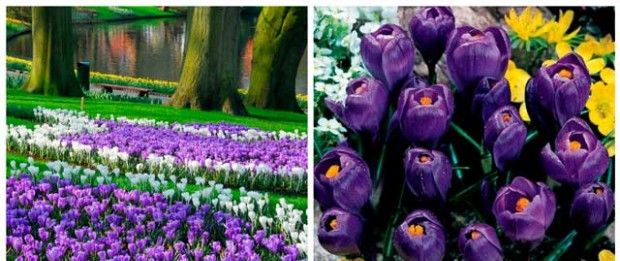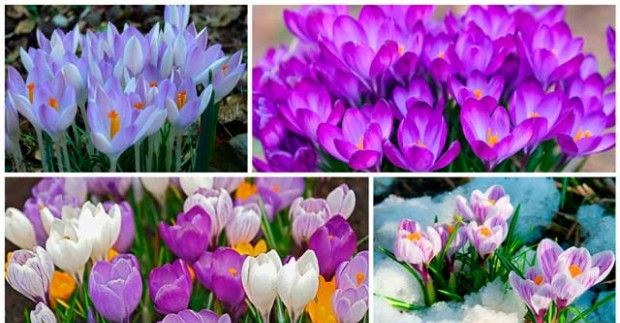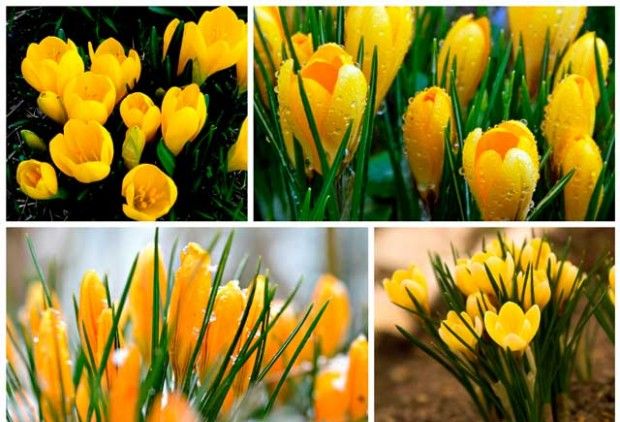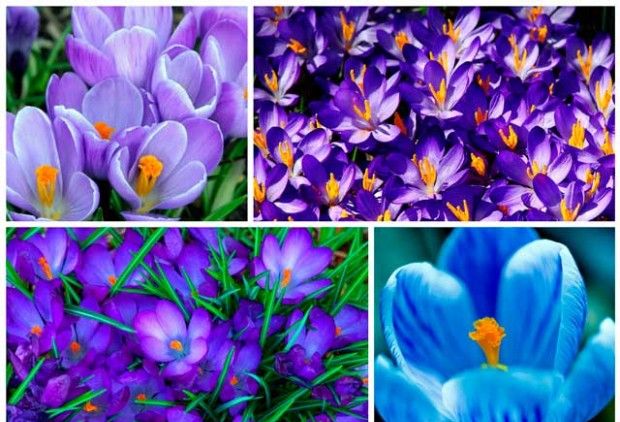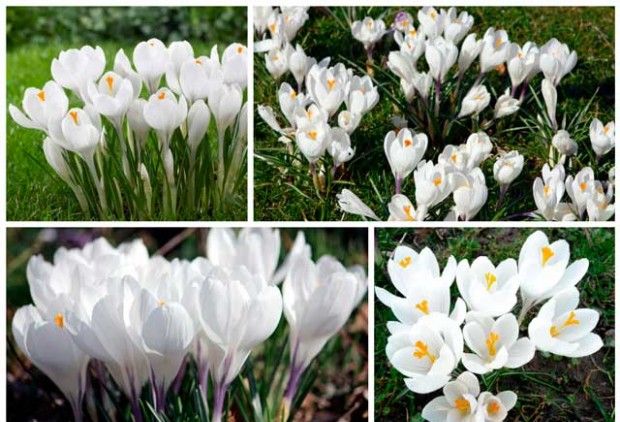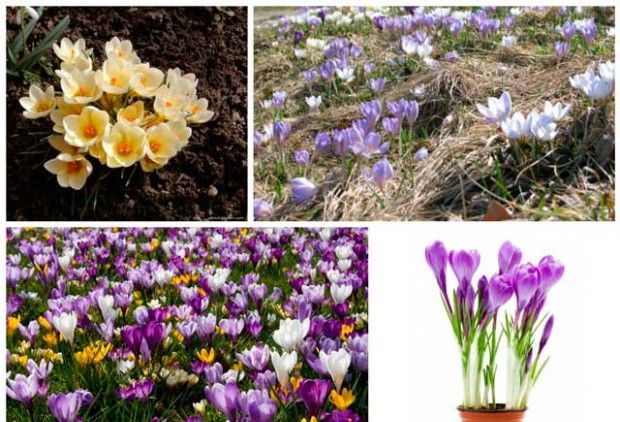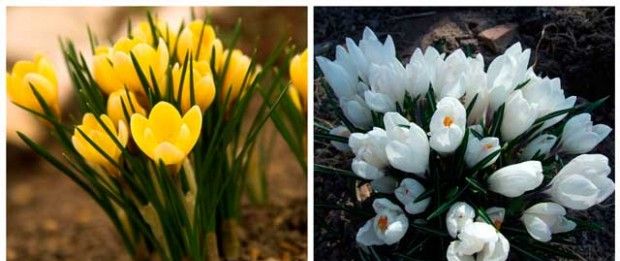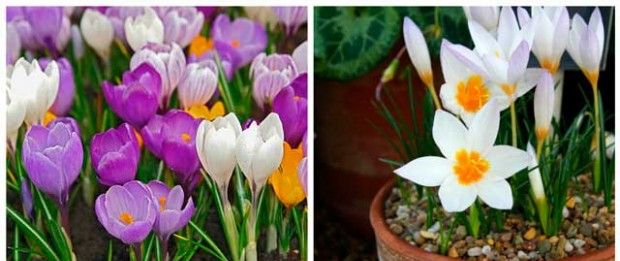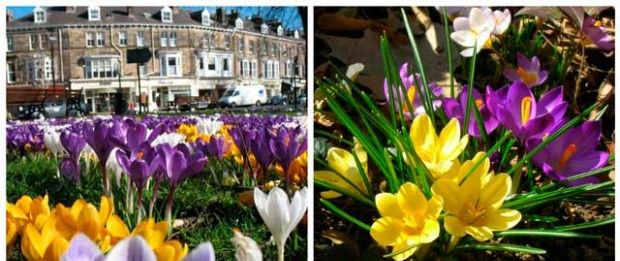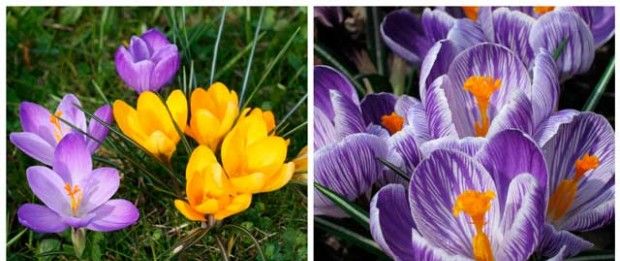As soon as the snow melts, crocuses bloom, decorating alpine slides, borders, flower beds with colorful flowers. One of the leaf rosettes gave its name. «Kroke» translated from Greek means thread. Flowers are more common in the wild in the Crimea, the Baltic States, the Caucasus, the Pyrenees, and Asia Minor. Although it is known over 200 types, the assortment is considered to be poor. They are appreciated not only for their beauty, but also for their ability to set off the taste and color of food. The familiar saffron is the crushed stigmas of cold-resistant flowers.
Crocuses: growing, care, features
Height compact bush – 10 cm. Depending on the variety, the corms form up to 6 flowers ranging in size from 3, 5 to 6, 5 cm. In some species, up to 20. They look beautiful in compositional design, when several plants of the same species grow on the same flower bed, but different shades. Combine well with other primroses.
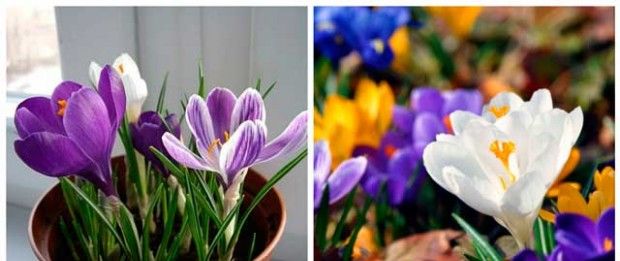
Depending on the variety flowering time differs by 15 days. The period lasts 11-14 days and is influenced by weather conditions. After wilting, the leaves remain green until the sun bakes. By mid-June they dry out. During dormancy, the corms are dug up, sorted, then planted at the end of September. Until this time, they are stored at 23 ° C. Can be left in the flowerbed, provided that dry fragments are removed. Growing in one place for 6 years.
After flowering, when the leaves have not yet dried, annuals are planted. It is important not to touch the tubers during weeding. If it happened, the tubers are dug out, sprinkled with ash, lie on the windowsill for a week. The root system tolerates cold well, but the flowerbed is better in autumn insulate leaves and branches. Planting time for autumn varieties is the 3rd decade of July. Can be grown in pots, only they need different care.
Types and varieties of crocuses
Spring and autumn varieties are planted in gardens and parks. Compared to early late species:
- inferior in size;
- differ in narrow lobes;
- less commonly used in landscape design.
Among spring botanical species spread are: golden-flowered crocus, Tommasini, Rubi Giant. Taplow Ruby corms form up to 20 variegated buds.
Yellow crocuses: Iellow Mammouth, Suzina with purple strokes on the perianth, Gipsy Girl, Large Iellow, Cream Beauty.
Blue and purple:
- Little Dorrit and Flower Record are the first to bloom. Both species are distinguished by large petals – 6.2 cm. Queen oj the Blues is slightly inferior (5.5 cm).
- Particularly Beautiful: Blue Bird, Purpureus Grandiflorus, Remembrance, Eaily Perfection, Skyline, Blue Pete, Negroboy.
Popular white varieties: White Beauty, Snow Bun, Albus Spinozus, two-tone striped: King of the Striped, Striped Beauty.
Dutch crocuses appeared as a result of crossing 2 varieties – spring and golden. The collection is presented in rainbow colors. Stand out against the background of others: lilac Joan of Arc, white Joan of Arc with many flowers. Suitable for distillation: Flower Record, Early Perfektion.
The collection of autumn plants is not so diverse. Popular species – beautiful crocus (propagating by seedlings, cultivated saffron).
Outdoor crocus care
Flowers do not like acidic soil. It is better to prepare the earth in advance. River sand with rotted manure is poured into heavy soil at the rate of 15 kg per 1 sq. m. Whimsical varieties are planted on bulk beds of drainage and gravel. Alpine slides are ideal. It is better to do without manure here, otherwise the root system will die. Digging is performed by 20 cm.
Areas contaminated with weed rhizomes are not suitable for planting. Where the snowdrifts lie for a long time, it is also not worth planting them. This prevents sprouting and abundant flowering. It is better to choose an open place, but in partial shade, some varieties, like a valley one, Sharoyan feel comfortable. The flowering period also depends on the location of the flower bed. In places with diffused sunlight, the bud opening time is postponed by 10 days. Autumn species prefer to grow in direct light. The buds fully open in sunny weather and only slightly on cloudy days.
Depth of pits affects flowering. Flowers are well formed in holes up to 10 cm, but corms are not large. It is recommended to plant them at a distance of up to 15 cm. The distance between the rows is 5 cm. It is better to pour crushed stone into the hole for drainage. In order to decorate the flower beds, flowers are planted nearby. However, it is necessary to take into account the growing period in one place. With long-term cultivation in one area without digging, it is better to do with a rare planting.
Seed propagation method suitable for valuable species in order to obtain planting material. Before landing in the ground, they are stratified. Seedlings are small, so it is better to plant them in containers, cover with spunbond or black film. In the first case, watering is not required before seedlings appear. The first flowers of seedlings appear after 3 years.
Care consists in weeding, loosening, two dressings mineral fertilizers during the period of active growth. The first time they are scattered over the snow. At the beginning of the growing season, it is allowed to add urea, but if time is missed, nitrogen will stimulate not only the growth of leaves, but also cause a fungal disease. After flowering, poor soils are fed with mineral fertilizers from phosphorus, potassium and a small amount of nitrogen. On rich soils, superphosphate is applied – 25 g per 1 sq.m. Phosphorus is essential for abundant flowering, potassium for healthy bulbs. It is important to observe watering mode. The roots do not tolerate excessive moisture. The exception is the crocuses of Sharoyan and Geifel.
Crocus pests and diseases
Like all bulbs, flowers have problems. When light spots appear, the buds do not open. Plants are harvested, the earth is treated with a solution of potassium permanganate.
Dangerous fungal diseases. Their presence is evidenced by dots, spots under the scales transforming into fusarium, sclerocial and penicillous rot. If, before planting the corms, they are treated with a special solution and dried, an unpleasant phenomenon can often be avoided.
- Bulbs are always inspected for mold before planting..
- Fresh material is not placed next to old plantings.
- When flowers are late planted, they do not have time to form a strong root system. In the spring they quickly rot and die. Plants are immediately harvested.
Flowers often appear with compressed petals that open in half. Such plants are called viral and must be distinguished from faded plants, in which a semi-dry glass falls on its side. Patients are characterized by faded spots on the buds. Pathogenic microbes from the juice are carried aphids and thrips, which leads to the infection of neighboring ones. Spring crocus hybrids suffer more often. Diseased bulbs are thrown away.
Small holes in the yellow tubers – the result of the activity of wireworms – click beetles. If there are a lot of them, at the end of April, bunches of not decayed grass or hay are buried in the ground, boards are placed on top. In search of warmth, beetles willingly move inside and after a couple of days they generously cover the surface with yellow dots. The straw is removed and burned. The process is repeated many times. Slugs like to live on groundbred ones, so crocuses are planted away from thyme or phlox, otherwise even the stems will not be left from the flowers.
Last tip: you don’t need to grow flowers in one place for years


